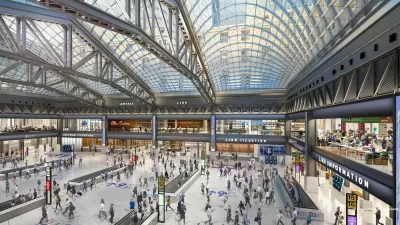Michael Kimmelman, newish architecture critic for The New York Times, adds his two cents to the decades old discussion of how to improve Penn Station. His solution starts with moving Madison Square Garden.
Kimmelman lays out the key elements of the ongoing argument for the need to renovate Penn Station, "probably the busiest transit hub in the Western world," and the sad reality that current plans to renovate the Farley Post Office building as Moynihan Station would only improve conditions for 5% of its daily passengers.
I don't think many would quibble with the need to improve Penn Station, but what has eluded the dozens of developers, planners, architects, and public officials over the years is an achievable plan to rehabilitate the existing Penn Station. Of course, Kimmelman's idea for removing Madison Square Garden is not new. As recently as the height of the building boom in 2007, planning was far along (led a public/private development partnership) to provide a new basketball arena in the western half of the Farley Post Office building, allowing for the wholesale renovation of the existing Penn Station.
So, what has changed since 2007, besides the crash of the real estate environment that made such grand plans seem achievable? Kimmelman hopes that the proposed redevelopment of the Javits Center along with "the glamour of a new arena alongside the High Line, with the boon of the No. 7 extension and the added benefit of dedicated bus service from Penn Station to 34th Street and 11th Avenue," will provide an adequate draw.
FULL STORY: Restore a Gateway to Dignity

Planetizen Federal Action Tracker
A weekly monitor of how Trump’s orders and actions are impacting planners and planning in America.

Congressman Proposes Bill to Rename DC Metro “Trump Train”
The Make Autorail Great Again Act would withhold federal funding to the system until the Washington Metropolitan Area Transit Authority (WMATA), rebrands as the Washington Metropolitan Authority for Greater Access (WMAGA).

The Simple Legislative Tool Transforming Vacant Downtowns
In California, Michigan and Georgia, an easy win is bringing dollars — and delight — back to city centers.

The States Losing Rural Delivery Rooms at an Alarming Pace
In some states, as few as 9% of rural hospitals still deliver babies. As a result, rising pre-term births, no adequate pre-term care and harrowing close calls are a growing reality.

The Small South Asian Republic Going all in on EVs
Thanks to one simple policy change less than five years ago, 65% of new cars in this Himalayan country are now electric.

DC Backpedals on Bike Lane Protection, Swaps Barriers for Paint
Citing aesthetic concerns, the city is removing the concrete barriers and flexposts that once separated Arizona Avenue cyclists from motor vehicles.
Urban Design for Planners 1: Software Tools
This six-course series explores essential urban design concepts using open source software and equips planners with the tools they need to participate fully in the urban design process.
Planning for Universal Design
Learn the tools for implementing Universal Design in planning regulations.
Smith Gee Studio
City of Charlotte
City of Camden Redevelopment Agency
City of Astoria
Transportation Research & Education Center (TREC) at Portland State University
US High Speed Rail Association
City of Camden Redevelopment Agency
Municipality of Princeton (NJ)



























